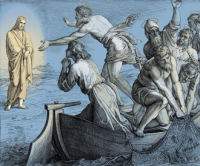
The beautiful chapter 21 of John’s gospel is somewhat mysterious, because chapter 20 seems to have already drawn the gospel to a conclusion. There could be many reasons why there is an additional chapter. Maybe the author felt that he wanted to provide further evidence of the Resurrection and the role of Peter as leader of the church. It is interesting too that this is a Galilean appearance, unlike the other ones in John’s gospel which take place in Jerusalem; so it is likely that this story belongs to a separate tradition. The focus is very much on Peter. It’s as though, by choosing to go back to his old occupation as a fisherman, he is given the opportunity to review this past life before he is able to move forward to new horizons.
He is back in his old environment, there is the miraculous draught of fishes (Luke 5:1-11), which numbered 153, which St Jerome recounts was the number Greek zoologists knew. This could suggest that the disciples, fishers of men (Lk. 5:10), would be catching a wide variety of people. On the shore is a charcoal fire, which recalls the the one where Peter warmed his hands (Jn 18:18). Peter leaps out of the boat, as he had done when Jesus walked on the water (Matt. 14:29). Now it is as though Jesus re-enacts the Last Supper, by cooking breakfast for his friends; a task of love, like washing their feet. Then he breaks bread so it becomes a eucharistic feast.
Peter must have remembered at this meal how he had boasted that he would die for Jesus (Jn 13:37). His Lord then allowed him to make the threefold declaration of love,, and confirmed his leadership by making him shepherd of his flock. Furthermore, he made clear to him that the love he had expressed would be shown when he finally gave his life for him. By the time this gospel was written, probably between 90-100 AD, Peter had already done this.